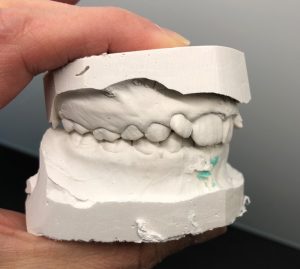The way we breathe, swallow, chew and what we do with our lips, cheeks and tongues when we’re not talking or eating (our function) as a baby or toddler can influence the development of our faces and jaws – our bony structure.
What happens though, if we try to improve the way we function later on but have great difficulties in doing so?
As an Oral Health Therapist and Orofacial Myofunctional Therapist, I have seen many children and adults struggle with trying to improve the way they function because their top jaw is too small or their lower jaw is too far back.
Commonly, children who have a deep bite and a retruded lower jaw (mandible) have great difficulties in keeping their lips together without engaging the wrong facial muscles. Their lips have to stretch further to meet and often use the chin muscle to compensate.
With these type of deep bites, I often notice that the 6 year old molars have not had the chance to erupt fully into the mouth, which can be an issue later on. These back teeth are very important for setting up the long-term stability of the jaw joint.
Adding bite pads to the baby molar teeth to ‘jack open the bite’, allows the 6 year old molars to further erupt. When the baby teeth fall out, so do the bite pads but the 6 year old molars have positioned themselves well by then. Often the lower jaw is more centred and forward, the lips can be kept together effortlessly, jaw joints are happier and kids can breathe better during sleep. I have seen children stop snoring and cease teeth grinding when bite pads have been placed!
Having the bite opened up and the lower jaw guided forward with bite pads, in some cases, can make establishing correct function and myofunctional therapy more successful.
Having a great network of dental professionals to refer to for this type of intervention is important!

9 year old patient with a deep bite


Bite pads added to ope up the bite to allow the 6 year old molars to erupt further, guide the lower jw forward and help patient to keep lips together.



